Physical Security Report: Levels, Planning and Security Plan Details
VerifiedAdded on 2022/08/19
|5
|739
|16
Report
AI Summary
This report provides an overview of physical security, detailing various levels from minimum to maximum, and the value of planning. It explains the different levels of security, including the measures and technologies used at each level, such as locks, alarms, CCTV, and access controls. The report also emphasizes the importance of value planning in the early stages of a project. Furthermore, it outlines the essential information content of a security plan, including the organization's vulnerabilities, the impact and likelihood of threats, mitigation processes, and contingency planning. The report references several sources to support the information provided, making it a comprehensive resource for understanding and implementing effective physical security measures.
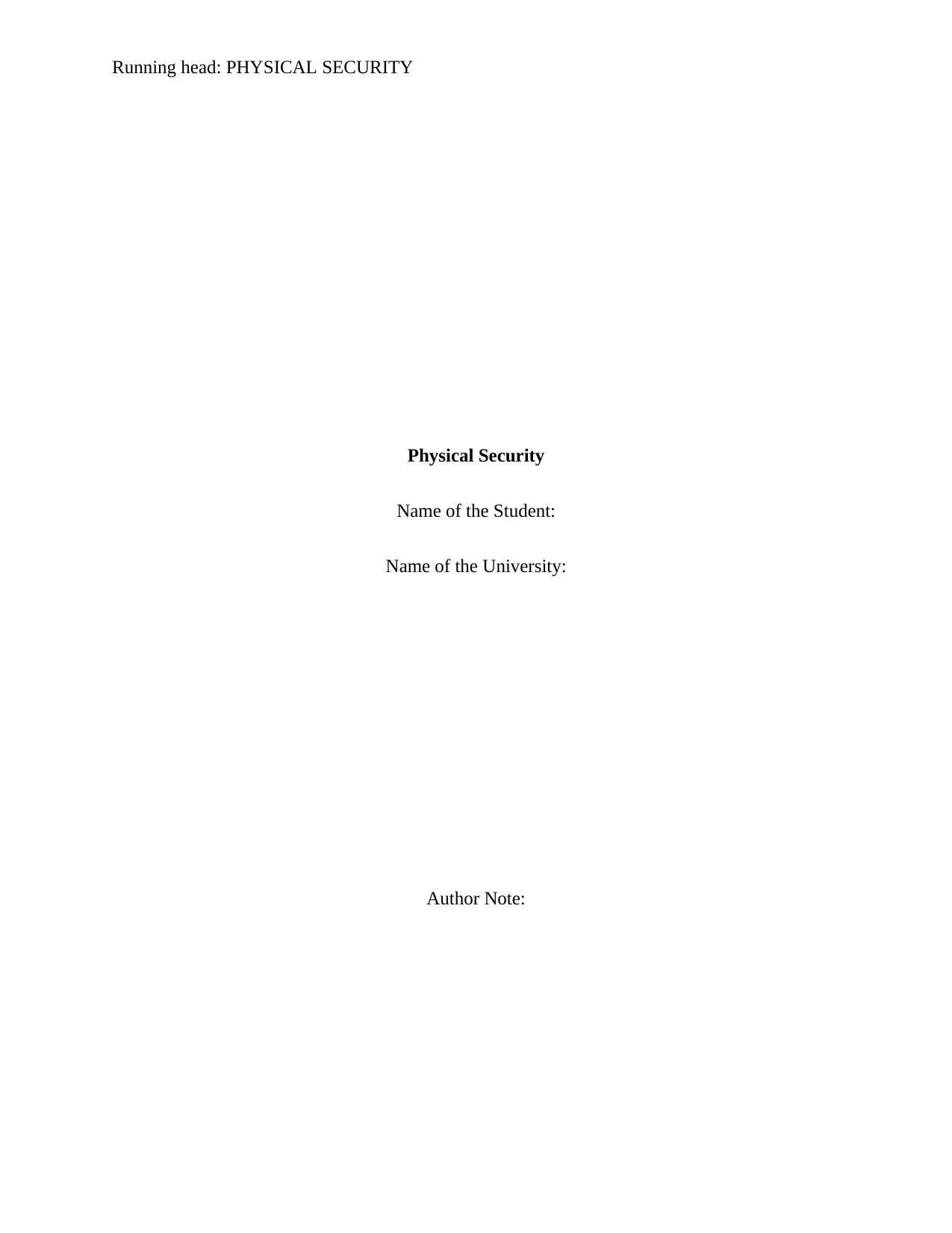
Running head: PHYSICAL SECURITY
Physical Security
Name of the Student:
Name of the University:
Author Note:
Physical Security
Name of the Student:
Name of the University:
Author Note:
Paraphrase This Document
Need a fresh take? Get an instant paraphrase of this document with our AI Paraphraser
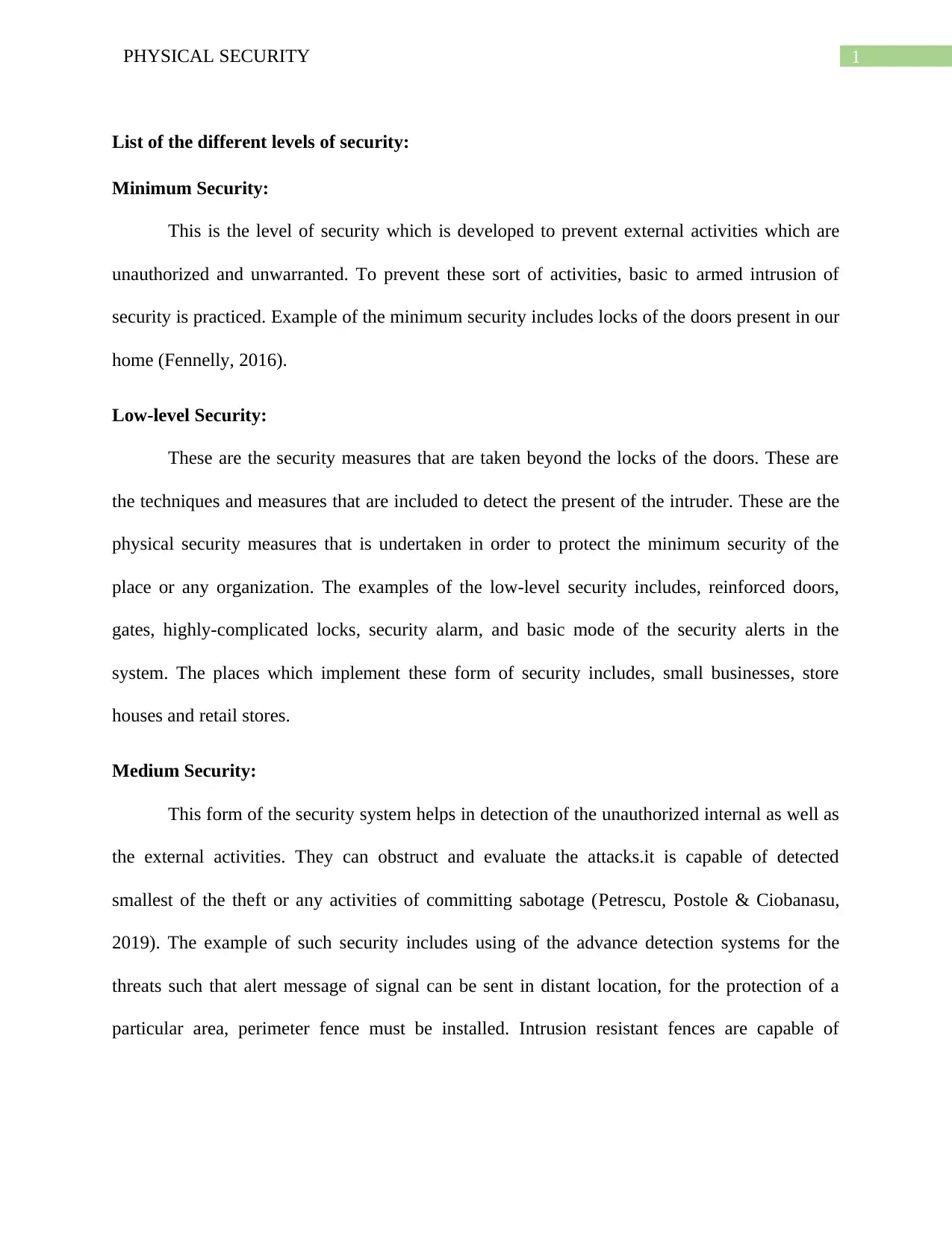
1PHYSICAL SECURITY
List of the different levels of security:
Minimum Security:
This is the level of security which is developed to prevent external activities which are
unauthorized and unwarranted. To prevent these sort of activities, basic to armed intrusion of
security is practiced. Example of the minimum security includes locks of the doors present in our
home (Fennelly, 2016).
Low-level Security:
These are the security measures that are taken beyond the locks of the doors. These are
the techniques and measures that are included to detect the present of the intruder. These are the
physical security measures that is undertaken in order to protect the minimum security of the
place or any organization. The examples of the low-level security includes, reinforced doors,
gates, highly-complicated locks, security alarm, and basic mode of the security alerts in the
system. The places which implement these form of security includes, small businesses, store
houses and retail stores.
Medium Security:
This form of the security system helps in detection of the unauthorized internal as well as
the external activities. They can obstruct and evaluate the attacks.it is capable of detected
smallest of the theft or any activities of committing sabotage (Petrescu, Postole & Ciobanasu,
2019). The example of such security includes using of the advance detection systems for the
threats such that alert message of signal can be sent in distant location, for the protection of a
particular area, perimeter fence must be installed. Intrusion resistant fences are capable of
List of the different levels of security:
Minimum Security:
This is the level of security which is developed to prevent external activities which are
unauthorized and unwarranted. To prevent these sort of activities, basic to armed intrusion of
security is practiced. Example of the minimum security includes locks of the doors present in our
home (Fennelly, 2016).
Low-level Security:
These are the security measures that are taken beyond the locks of the doors. These are
the techniques and measures that are included to detect the present of the intruder. These are the
physical security measures that is undertaken in order to protect the minimum security of the
place or any organization. The examples of the low-level security includes, reinforced doors,
gates, highly-complicated locks, security alarm, and basic mode of the security alerts in the
system. The places which implement these form of security includes, small businesses, store
houses and retail stores.
Medium Security:
This form of the security system helps in detection of the unauthorized internal as well as
the external activities. They can obstruct and evaluate the attacks.it is capable of detected
smallest of the theft or any activities of committing sabotage (Petrescu, Postole & Ciobanasu,
2019). The example of such security includes using of the advance detection systems for the
threats such that alert message of signal can be sent in distant location, for the protection of a
particular area, perimeter fence must be installed. Intrusion resistant fences are capable of
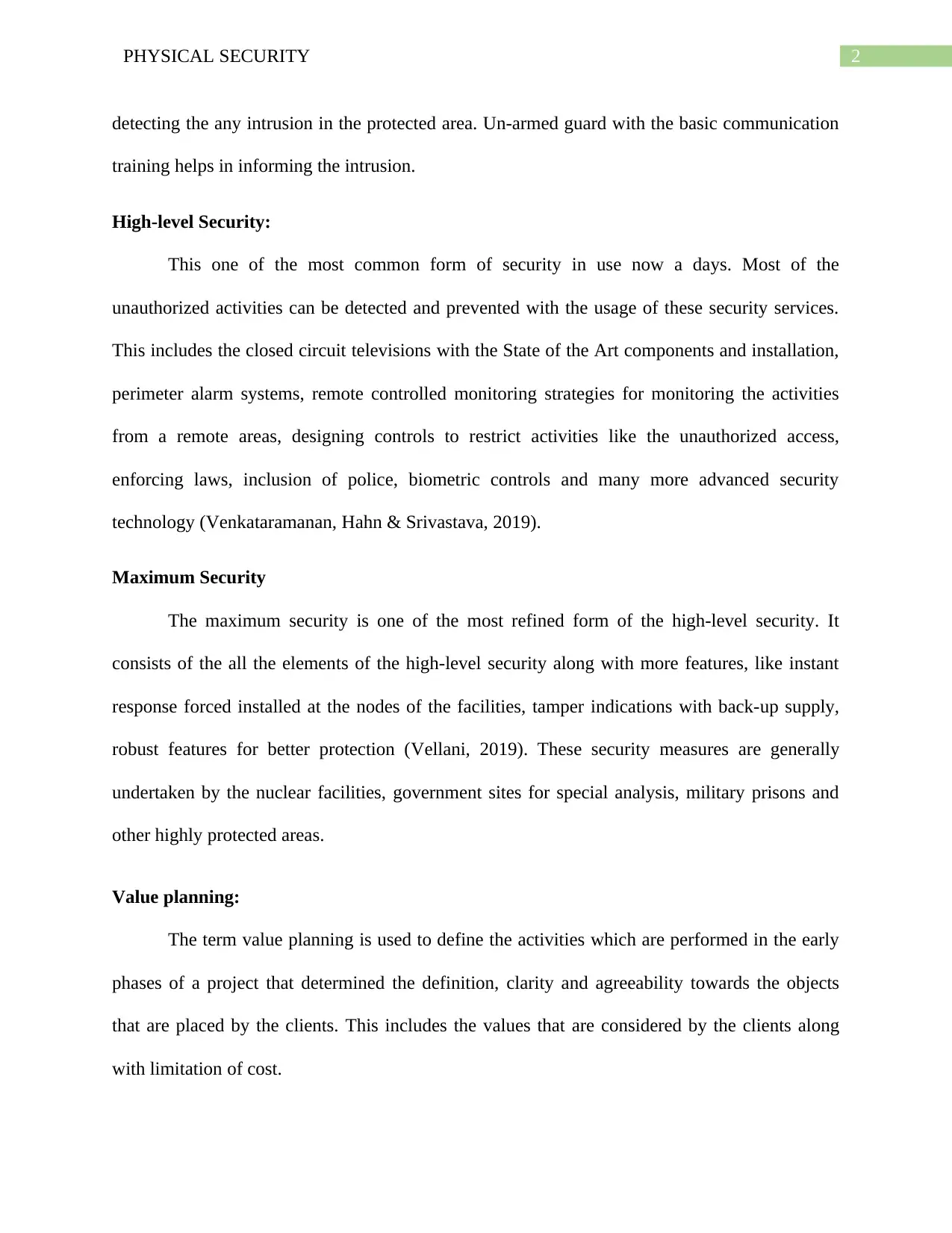
2PHYSICAL SECURITY
detecting the any intrusion in the protected area. Un-armed guard with the basic communication
training helps in informing the intrusion.
High-level Security:
This one of the most common form of security in use now a days. Most of the
unauthorized activities can be detected and prevented with the usage of these security services.
This includes the closed circuit televisions with the State of the Art components and installation,
perimeter alarm systems, remote controlled monitoring strategies for monitoring the activities
from a remote areas, designing controls to restrict activities like the unauthorized access,
enforcing laws, inclusion of police, biometric controls and many more advanced security
technology (Venkataramanan, Hahn & Srivastava, 2019).
Maximum Security
The maximum security is one of the most refined form of the high-level security. It
consists of the all the elements of the high-level security along with more features, like instant
response forced installed at the nodes of the facilities, tamper indications with back-up supply,
robust features for better protection (Vellani, 2019). These security measures are generally
undertaken by the nuclear facilities, government sites for special analysis, military prisons and
other highly protected areas.
Value planning:
The term value planning is used to define the activities which are performed in the early
phases of a project that determined the definition, clarity and agreeability towards the objects
that are placed by the clients. This includes the values that are considered by the clients along
with limitation of cost.
detecting the any intrusion in the protected area. Un-armed guard with the basic communication
training helps in informing the intrusion.
High-level Security:
This one of the most common form of security in use now a days. Most of the
unauthorized activities can be detected and prevented with the usage of these security services.
This includes the closed circuit televisions with the State of the Art components and installation,
perimeter alarm systems, remote controlled monitoring strategies for monitoring the activities
from a remote areas, designing controls to restrict activities like the unauthorized access,
enforcing laws, inclusion of police, biometric controls and many more advanced security
technology (Venkataramanan, Hahn & Srivastava, 2019).
Maximum Security
The maximum security is one of the most refined form of the high-level security. It
consists of the all the elements of the high-level security along with more features, like instant
response forced installed at the nodes of the facilities, tamper indications with back-up supply,
robust features for better protection (Vellani, 2019). These security measures are generally
undertaken by the nuclear facilities, government sites for special analysis, military prisons and
other highly protected areas.
Value planning:
The term value planning is used to define the activities which are performed in the early
phases of a project that determined the definition, clarity and agreeability towards the objects
that are placed by the clients. This includes the values that are considered by the clients along
with limitation of cost.
⊘ This is a preview!⊘
Do you want full access?
Subscribe today to unlock all pages.

Trusted by 1+ million students worldwide
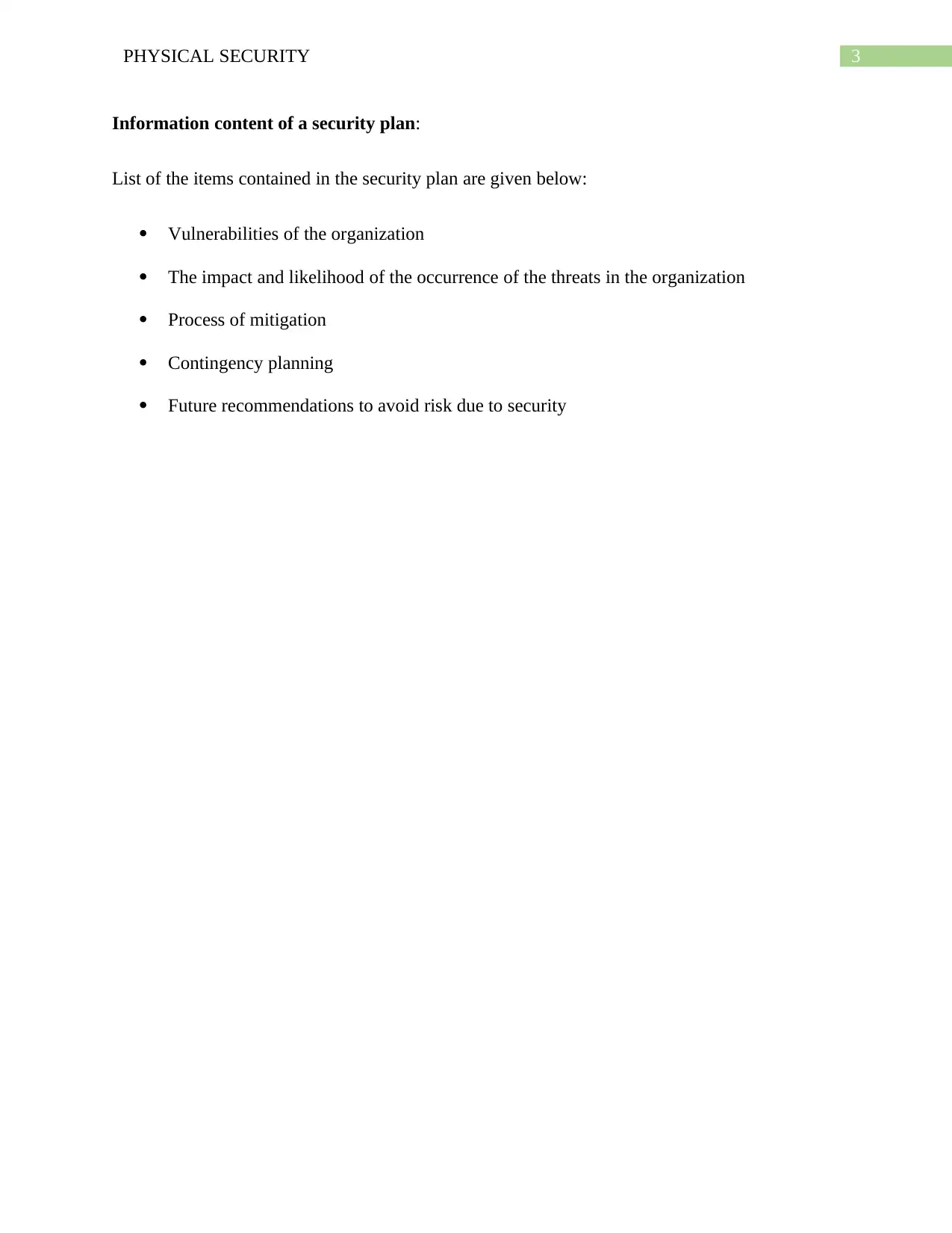
3PHYSICAL SECURITY
Information content of a security plan:
List of the items contained in the security plan are given below:
Vulnerabilities of the organization
The impact and likelihood of the occurrence of the threats in the organization
Process of mitigation
Contingency planning
Future recommendations to avoid risk due to security
Information content of a security plan:
List of the items contained in the security plan are given below:
Vulnerabilities of the organization
The impact and likelihood of the occurrence of the threats in the organization
Process of mitigation
Contingency planning
Future recommendations to avoid risk due to security
Paraphrase This Document
Need a fresh take? Get an instant paraphrase of this document with our AI Paraphraser
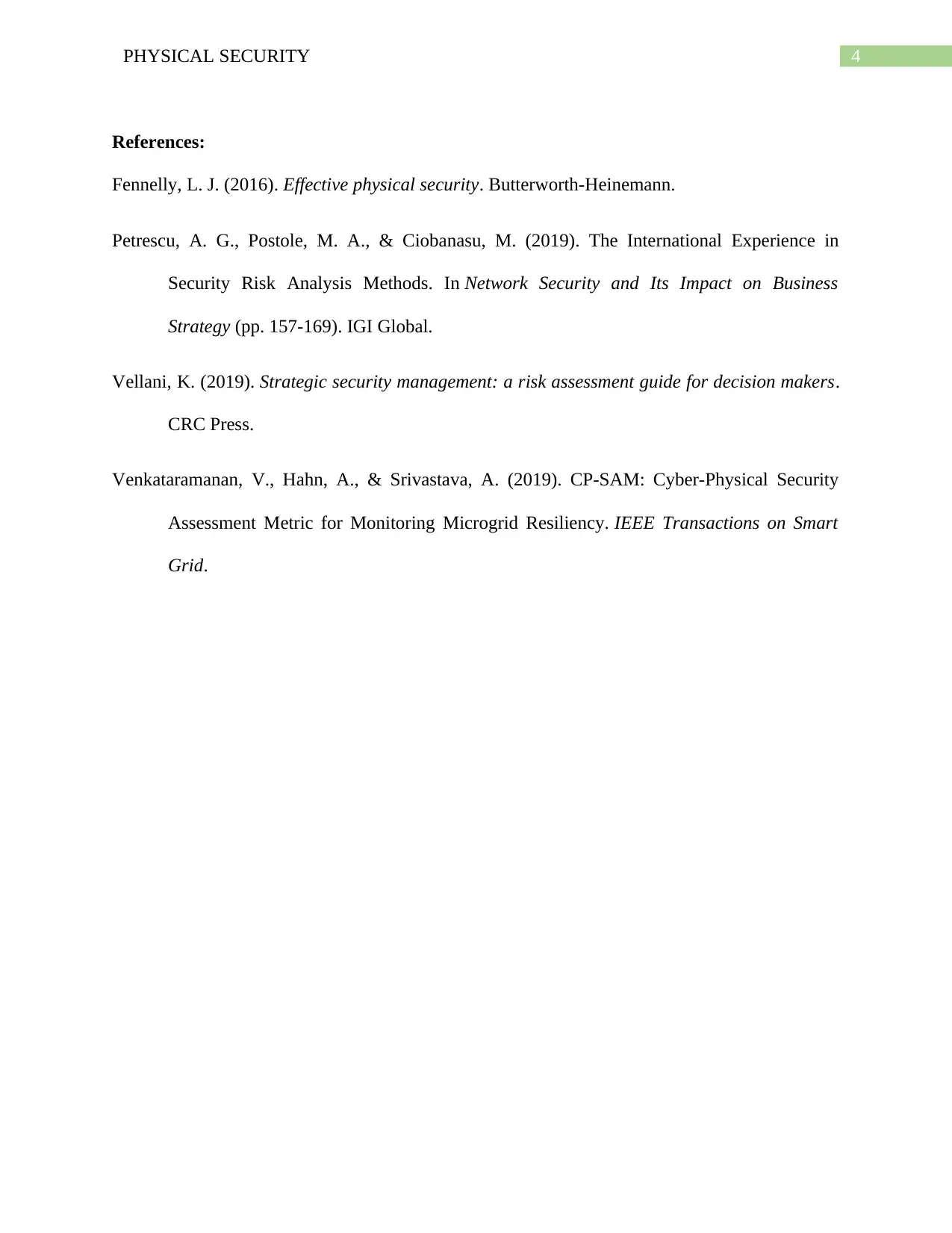
4PHYSICAL SECURITY
References:
Fennelly, L. J. (2016). Effective physical security. Butterworth-Heinemann.
Petrescu, A. G., Postole, M. A., & Ciobanasu, M. (2019). The International Experience in
Security Risk Analysis Methods. In Network Security and Its Impact on Business
Strategy (pp. 157-169). IGI Global.
Vellani, K. (2019). Strategic security management: a risk assessment guide for decision makers.
CRC Press.
Venkataramanan, V., Hahn, A., & Srivastava, A. (2019). CP-SAM: Cyber-Physical Security
Assessment Metric for Monitoring Microgrid Resiliency. IEEE Transactions on Smart
Grid.
References:
Fennelly, L. J. (2016). Effective physical security. Butterworth-Heinemann.
Petrescu, A. G., Postole, M. A., & Ciobanasu, M. (2019). The International Experience in
Security Risk Analysis Methods. In Network Security and Its Impact on Business
Strategy (pp. 157-169). IGI Global.
Vellani, K. (2019). Strategic security management: a risk assessment guide for decision makers.
CRC Press.
Venkataramanan, V., Hahn, A., & Srivastava, A. (2019). CP-SAM: Cyber-Physical Security
Assessment Metric for Monitoring Microgrid Resiliency. IEEE Transactions on Smart
Grid.
1 out of 5
Related Documents
Your All-in-One AI-Powered Toolkit for Academic Success.
+13062052269
info@desklib.com
Available 24*7 on WhatsApp / Email
![[object Object]](/_next/static/media/star-bottom.7253800d.svg)
Unlock your academic potential
Copyright © 2020–2025 A2Z Services. All Rights Reserved. Developed and managed by ZUCOL.





